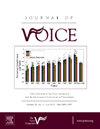Systematic Review of Recurrence Rates of Benign Vocal Fold Lesions Following Surgery
IF 2.5
4区 医学
Q1 AUDIOLOGY & SPEECH-LANGUAGE PATHOLOGY
引用次数: 0
Abstract
Objectives
Benign vocal fold lesions which include vocal fold nodules, polyps, cysts and other lesions often recur after surgery and require additional treatments. This systematic review of the current literature evaluated the effects of adjunctive therapies in addition to surgical resection on the recurrence rates of benign vocal fold lesions in adults.
Study Design
Systematic review.
Methods
A search using relevant keywords in electronic databases was conducted. Extracted data include author, year of publication, patient demographics, diagnostic approach, lesion type, surgical procedure, type of adjunctive therapy and the rates of recurrence. Descriptive statistics were performed on the collected data when appropriate.
Results
Eleven articles were identified with a total of 1085 patients. The total 1101 lesions studied included 591 (53.7%) polyps, 125 (11.4%) nodules, 146 (13.3%) cysts, 184 (16.7%) pseudocysts, 19 (1.7%) midfold masses, 18 (1.6%) sulcus vocalis and 18 (1.6%) varices. Besides surgery, adjunctive therapies included voice therapy, steroid injection and reflux medication. There were 141 reported lesion recurrences, with an average recurrence rate of 13.0%. The recurrence rate in studies with adjunctive therapies was 7.14%, and in studies with no adjunctive therapies it was 24.44%.
Conclusions
Available evidence suggests that adjunctive therapies following surgery are associated with decreased lesion recurrence rates. However, due to differences in sample size, inconsistent reporting of lesion characteristics, heterogeneity of adjunctive therapies, variability in follow-up time across studies, and other factors, it is not possible to determine exactly which adjunctive therapies are of significant benefit and which lesion types may benefit the most.
声带褶皱良性病变术后复发率的系统性综述
目的:声带良性病变包括声带小结、息肉、囊肿和其他病变,手术后往往会复发,需要进行其他治疗。本研究对现有文献进行了系统回顾,评估了除手术切除外,辅助疗法对成人声带良性病变复发率的影响:研究设计:系统综述:方法:使用相关关键词在电子数据库中进行检索。提取的数据包括作者、发表年份、患者人口统计学特征、诊断方法、病变类型、手术方法、辅助治疗类型和复发率。在适当的时候,对收集到的数据进行描述性统计:结果:共发现 11 篇文章,涉及 1085 名患者。研究的 1101 个病灶包括 591 个(53.7%)息肉、125 个(11.4%)结节、146 个(13.3%)囊肿、184 个(16.7%)假性囊肿、19 个(1.7%)中段肿块、18 个(1.6%)声带沟和 18 个(1.6%)静脉曲张。除手术外,辅助疗法还包括嗓音治疗、类固醇注射和反流药物治疗。据报道,有 141 例病变复发,平均复发率为 13.0%。在使用辅助疗法的研究中,复发率为 7.14%,而在未使用辅助疗法的研究中,复发率为 24.44%:现有证据表明,术后辅助疗法与降低病灶复发率有关。然而,由于样本量的差异、病变特征报告的不一致、辅助疗法的异质性、各研究随访时间的差异以及其他因素,目前还无法准确确定哪些辅助疗法具有显著疗效以及哪些病变类型可能受益最大。
本文章由计算机程序翻译,如有差异,请以英文原文为准。
求助全文
约1分钟内获得全文
求助全文
来源期刊

Journal of Voice
医学-耳鼻喉科学
CiteScore
4.00
自引率
13.60%
发文量
395
审稿时长
59 days
期刊介绍:
The Journal of Voice is widely regarded as the world''s premiere journal for voice medicine and research. This peer-reviewed publication is listed in Index Medicus and is indexed by the Institute for Scientific Information. The journal contains articles written by experts throughout the world on all topics in voice sciences, voice medicine and surgery, and speech-language pathologists'' management of voice-related problems. The journal includes clinical articles, clinical research, and laboratory research. Members of the Foundation receive the journal as a benefit of membership.
 求助内容:
求助内容: 应助结果提醒方式:
应助结果提醒方式:


